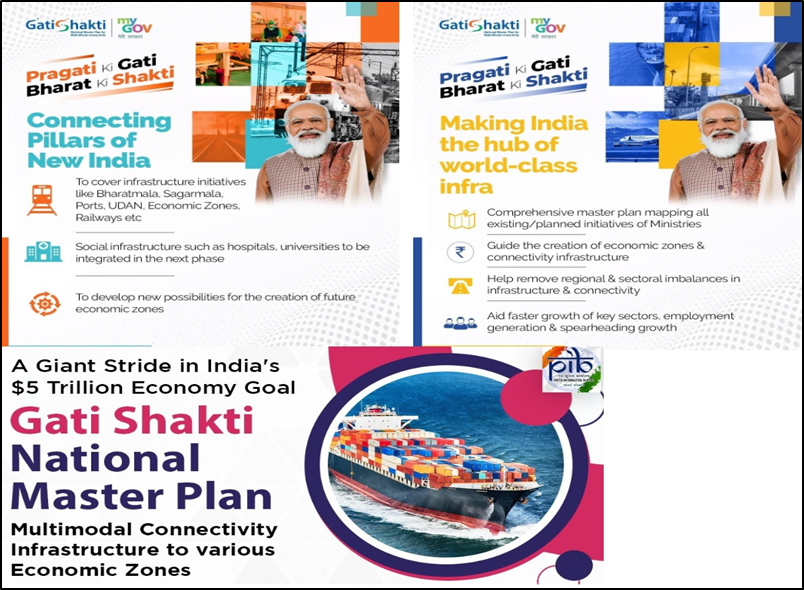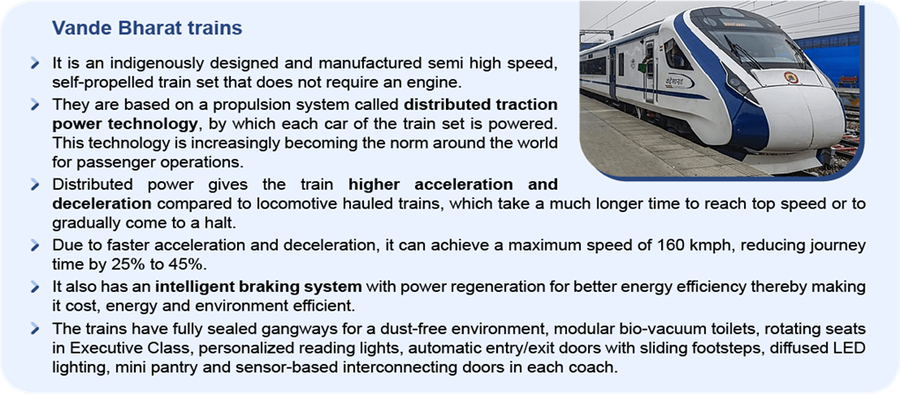In News:
- India's first semi-high speed freight train is likely to hit the tracks by December.
What’s in Today’s Article:
- Gati Shakti- National Master Plan – About, vision, scope, 6-pillars
- News Summary
Gati Shakti- National Master Plan
About

- In October 2021, PM Modi launched the Gati Shakti – National Master Plan for Multi-modal Connectivity in New Delhi.
- Gati Shakti — a digital platform — will bring 16 Ministries including Railways and Roadways together for integrated planning and coordinated implementation of infrastructure connectivity projects.
- PM GatiShakti is a transformative approach for economic growth and sustainable development. The approach is driven by 7 engines, namely:
- Railways; Roads; Ports; Waterways; Airports; Mass Transport; Logistics Infrastructure
Vision of PM Gati Shakti
- PM Gati Shakti will incorporate the infrastructure schemes of various Ministries and State Governments like Bharatmala, Sagarmala, inland waterways, dry/land ports, UDAN etc.
- Economic Zones such as textile clusters, pharmaceutical clusters, defence corridors, electronic parks, etc. will be covered to improve connectivity.
- It will also leverage technology extensively including spatial planning tools with ISRO imagery developed by BiSAG-N (Bhaskaracharya National Institute for Space Applications and Geoinformatics).
- Dynamic mapping of all infrastructure projects with real- time updation will be provided by way of a map developed by BISAG-N.
- The map will be built on open-source technologies and hosted securely on MEGHRAJ i.e. cloud of Govt. of India.
The scope of PM GatiShakti National Master Plan
- The scope of this Plan will encompass the 7 engines for economic transformation, seamless multimodal connectivity and logistics efficiency.
- It will also include the infrastructure developed by the State Governments.
- The focus will be on planning, financing including through innovative ways, use of technology and speedier implementation.
- The projects pertaining to these 7 engines in the “National Infrastructure Pipeline” will be aligned with PM GatiShakti framework.
6 Pillars of PM Gati Shakti
- Comprehensiveness:
- It will include all the existing and planned initiatives of various Ministries and Departments with one centralized portal.
- Each and every Department will now have visibility of each other's activities providing critical data while planning & execution of projects in a comprehensive manner.
- Prioritization:
- Through this, different Departments will be able to prioritize their projects through cross-sectoral interactions.
- Optimization:
- The National Master Plan will assist different ministries in planning for projects after identification of critical gaps.
- For the transportation of the goods from one place to another, the plan will help in selecting the most optimum route in terms of time and cost.
- Synchronization:
- Individual Ministries and Departments often work in silos. There is lack of coordination in planning and implementation of the project resulting in delays.
- PM Gati Shakti will help in synchronizing the activities of each department, as well as of different layers of governance.
- Analytical:
- The plan will provide the entire data at one place with GIS based spatial planning and analytical tools having 200+ layers, enabling better visibility to the executing agency.
- Dynamic:
- All Ministries and Departments will now be able to visualize, review and monitor the progress of cross-sectoral projects.
- This will be done through the GIS platform.
- It will help in identifying the vital interventions for enhancing and updating the master plan.
News Summary
- To tap the growing freight sector, the Railways is aiming to introduce the country’s first semi-high speed freight train by December 2022.
Key Highlights
- Based on the Vande Bharat platform, the 16-coach ‘Gati Shakti’ train will be able to run at 160 km/hour.
- It will be manufactured at the Integral Coach Factory (ICF) in Chennai.
- The Indian Railways has identified 74 new 'Gati-Shakti Multi-Modal Cargo Terminal (GCT) locations across the country.

Why the Railways is launching these trains?
- To target the e-commerce and courier parcel segment
- With a turnover of USD 50 billion in 2020, India has become the eighth largest market for e-commerce.
- India's ecommerce market is expected to reach $111 billion by 2024 and $200 billion by 2026 and expected to reach $350 billion by 2030.
- The Railways planned to capture the small size parcel shipments by running dedicated high speed freight trains.
- To ferry perishable items within stipulated time
- Each train would have two refrigerated wagons — the first and last cars, to ferry perishable items such as fruits and vegetables.
- To increase its share in freight transportation
- The Railways is aiming to increase its share in freight transportation from the present 27% to 45% by 2030 through better infrastructure and business development plans.










